|
|
|
Why are we concerned about Decon? The primary reason for decontaminating cave gear is to prevent bringing outside bacteria and fungi into the cave environment. These outside bacteria and fungus can compete for resources with native cave fauna. In 2006, a fungal disease called White Nose Syndrome (WNS) or Pseudogymnoascus destructans, was first brought to cavers' attention. We began to understand that the disease was killing many, many bats in caves in the eastern United States. During hibernation in a specific temperature - humidity zone, bats were developing a white fungus on their noses and wings. This fungus caused the bats to awaken during the winter months and use stored energy by scratching at the irritating fungus. Depending on the consumption of the winter store of energy, some bats had to fly out of the cave to find food. During the winter months, there are few if any bugs for bats to eat, and many bats died from starvation and exposure to the winter climate. It is speculated that the disease came across the Atlantic from Europe. How it arrived in the US is still not clear. Over the past decade numerous scientific studies have learned more about the disease as the bat deaths have slowly moved across the United States as far as the eastern border of Oklahoma. Bat to bat transmission is the primary WNS vector, but it is suspected that humans are also a potential vector. Recently bats in Washington State have been diagnosed with WNS and this has added to the mystery of transmission of WNS. Fort Stanton Cave has been closed during the winter hibernating months (November through April) for more than a decade, to let the bats hibernate in peace . The FSCSP has worked closely with the BLM Roswell Field Office (RFO), which is the primary public land manager of Fort Stanton Cave. Through an assistant agreement with BLM and our own funds we support all kinds of scientific research, including WNS research. Much of this work is documented in reports to the BLM and is often presented at the annual Southwest Region (SWR) Winter Tech meeting. Current WNS and decontamination data is available on the SWR website. Decon at Fort Stanton started with chemical treatment in 2011 at the April expedition. By the October 2012 expedition we had switched to a 121 ° F hot water decon process. The following year (October 2013) we upgraded to a propane- fired instant water heater mounted on the side of the bunkhouse building. This web page documents the 2016 design, fabrication and test by the RFO & FSCSP of a high capacity mobile propane-fired unit that is able to reach the higher 131° F decon temperature now required. This unit will be available for easy use at the 2017 NSS Convention in Rio Rancho, New Mexico. New Mexico and other western cavers concerned about the spread of WNS from infected cave areas believe that careful screening of cavers visiting from other areas where WNS has been detected is key to reducing the probability of WNS infection in our western caves and mines. Planning for the July 2016 NSS Convention included this concern and in April 2016, the FSCSP and the RFO initiated support of the design, development, fabrication and field testing of an updated modular version of the Decon system. The result was an improved Decon system that was field tested in Ely, Nevada, and was successfully used to decon caving gear both before and after all cavers visited a Nevada cave. Thanks to all the volunteers that assisted in Ely in July, and thanks to all the other cavers that have assisted in the design and development of this unique system over the past several years. This page summarizes that effort that resulted in a new unit we called the: ACME Decontaminator 5000 ( AD5K) |
||||
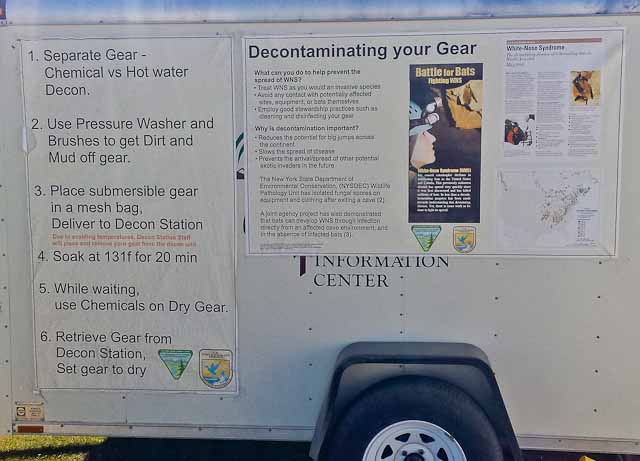 |
The BLM and FSCSP have a 5+ year history of working together on the issues of decontaminating gear going into and out of Fort Stanton Cave. This page details some of the history of these efforts that resulted in the design, fabrication and field deployment of a mobile Decon unit. |
|||
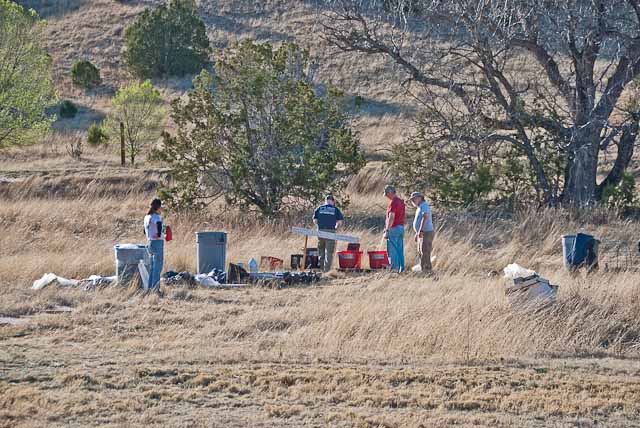 |
In 2011 we started using chemicals in plastic tubs along with a pressure washer to knock off the mud. But chemicals should not be dumped on the ground near streams nor placed in septic systems. We retired the chemical tubs in 2012. |
|||
 . . 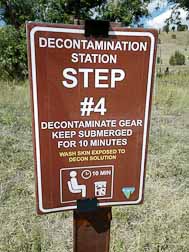 |
We were primarily concerned with cavers visiting from the East, where decon may not have been followed. Introduction of WNS spores could have been transported on clothing and equipment used in an eastern WNS cave. |
|||
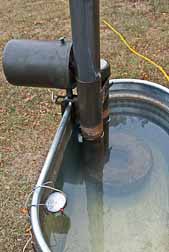 . . 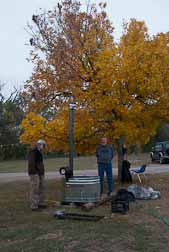 |
In 2012 we abandoned the chemical tank process. Mike Bilbo bought a military style M67 diesel / kerosene fueled immersion heater that we adapted to a 100 gallon steel tank. It took all day to fire up the heater and decon the gear up to 121° F, plus someone (thanks Hank!) had to stand by for fire safety reasons. |
|||
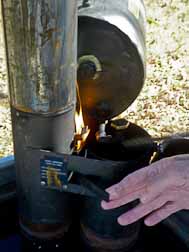 . . 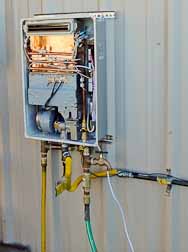 |
In October 2012 the M67 heater was replaced by an instant water heater fueled by propane from a 500 gallon tank. The flow-through design was wasteful of hot water and the tank had to be insulated. Mike re-used the old heavy steel signs to weight down milk carton baskets of gear. |
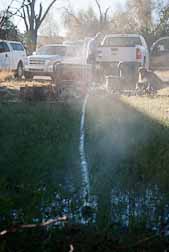 . .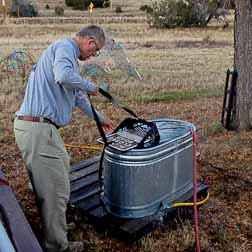 |
||
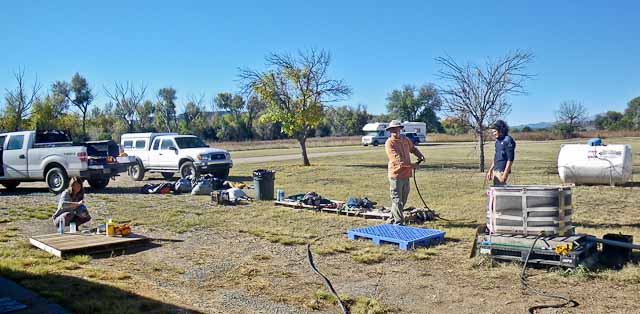 |
Insulating the top and sides of the metal tank allowed use during the colder fall months. Then in April 2016 the USFWS boosted the temperature requirements by 10° F! Our old insulated 100 gal. tank could barely reach 131 Deg. F. |
|||
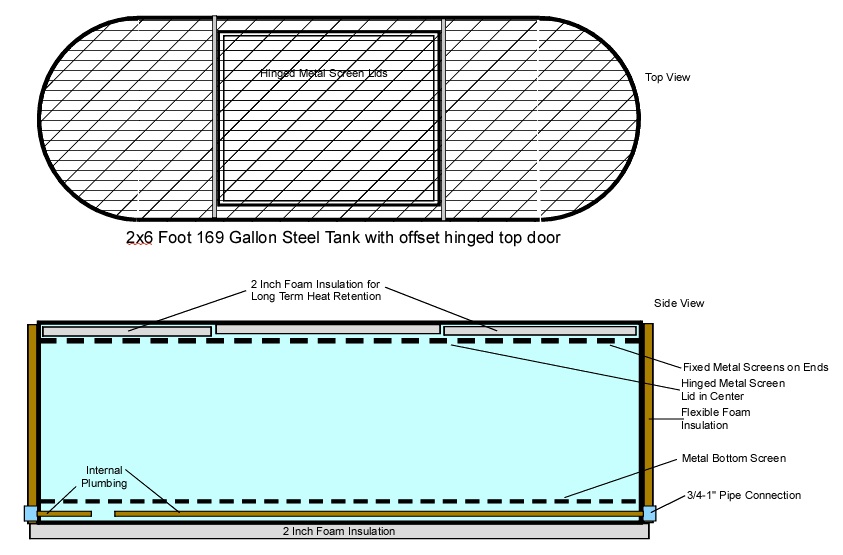 |
In April 2016 we began the design of a modular, trailer-portable instant water heater upgrade that would recirculate the hot water in a larger, insulated tank. The design improved over the next two months and in mid June, Knutt began welding the newly designed "lid" in Placitas, NM. |
|||
The key component was a specialty (beer) pump that was able to handle very hot water. Next we identified a hot water (plastic) filter that would assist in removal of mud from the recirculating system. Finally we obtained plumbing components and high temperature tubing from the local Tractor Supply store. |
||||
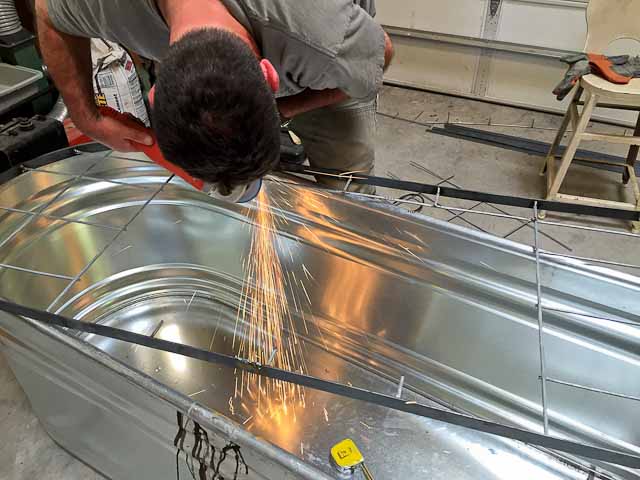 |
After grinding down the rough edges, a hinged door with a latch was constructed and the lid assembly was positioned 2 inches below the top of the tank to allow for foam insulation above the point where equipment floating to the top would be held under hot water. |
|||
Lessons Learned: Use a high pressure in-line regulator for the cold incoming water. Even the high temperature components can blow out under high pressure operating conditions. (With spare parts on hand, the repair took about five minutes.) |
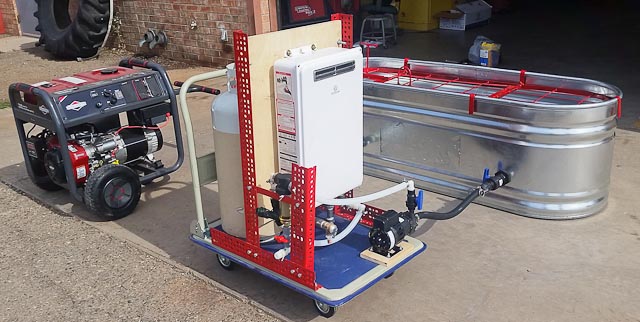 |
|||
Final assembly and painting was completed in Roswell, NM before transport to Fort Stanton for the initial field testing and application of the insulation. We mounted the bulk of the items on a medium-duty 4-wheel cart, balanced by the 40# (9 gallon) propane tank. |
||||
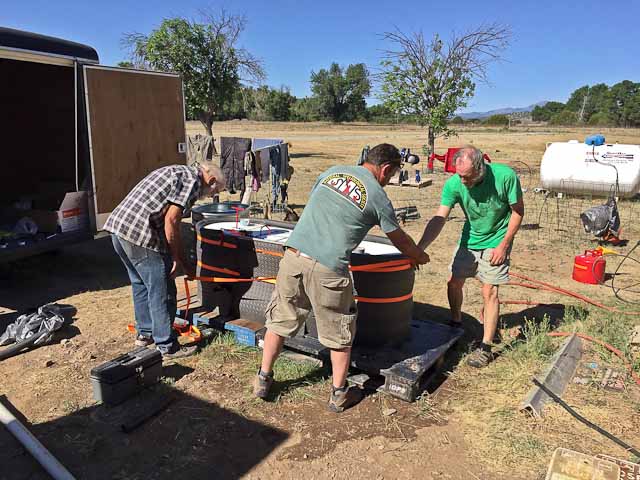 |
Nylon straps were used to bind the side insulation. The tank sits on a custom cut foam pad on top of the skids. The tank hookups are on a single side for easier transport. Future bonding of the insulation to the steel tank may provide improved thermal efficiency. |
|||
Since the pressure washer was a key component of the decon process, for remote locations we needed a generator, and of course the portable propane tank plus a smaller backup tank. Of course the whole kit had to fit in the 6 x 8 foot trailer. |
||||
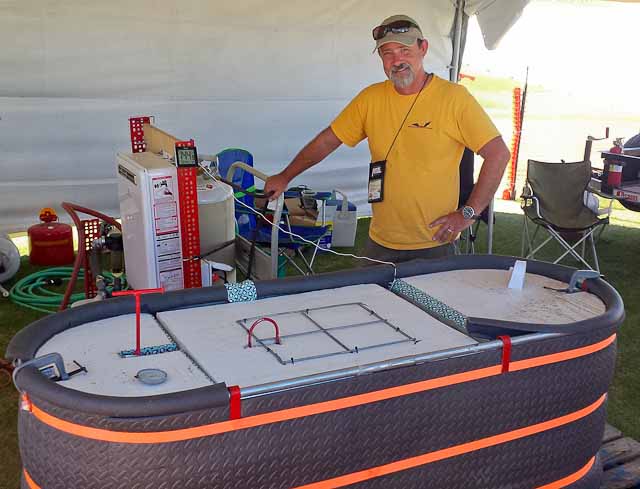 |
The tent provided by the 2016 Convention team was ideal for operating the AD5K decon tank manned by Knutt and other volunteers. This also provided an excellent public outreach to 1000 NSS cavers in explaining the whole process. The AD5K unit is capable of deconing 33 sets of gear per hour! At this rate, maintenance, cleaning of filters and the tub was once a day. |
|||
The first part of the decon process involved washing and rinsing the dirty equipment at the golf course camp site. Special items like cameras and gear that could not be placed in 140 degree water could be deconned with the wipes and chemicals on the table in the background. Using 12 gallons of propane, 321 sets of gear were decontaminated at the 2016 Ely convention! |
||||
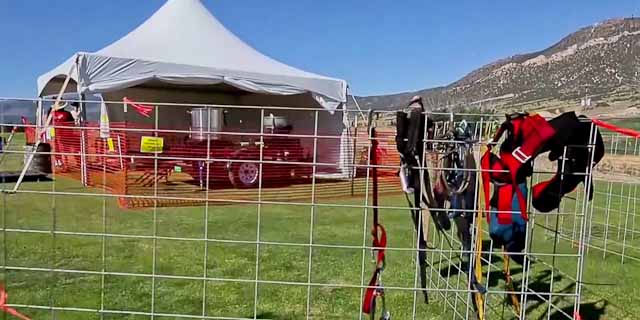 |
John Norman of the Desert Dog Troglodytes Grotto in Fullerton, California, describes the unit his Grotto built in a 10-day record time. Used to heat water for a hot tub, a sump pump was used to safely drain the large cooking pots. |
|||
 |
The Desert Dog backup unit, using 2 large cooking pots, can be seen just to the right of the AD5K. The DD unit was able to reach 131° F, but could only decon 3 sets of gear at a time. A lower cost unit than the AD5K, it is likely to be seen at future western caving activities. |
|||
(Click on most of the images above for larger images) |
||||
Click on the upper left link below for a 2016 NSS Convention video on both hot water units brought to Ely, NV. The lower two video links emphasize the older chemical treatment process, which still works well if you can properly dispose of the used chemicals. |
Although it should be obvious that chemical treatment must be handled with care, careful handling using hot water is ALSO very important. The warning on the right is part of the instructions delivered with instant hot water heater hardware. |
|||
![]()
Rev. 7-27-2019 |
Comments to the webmaster |
Contact the FSCSP President |
Contact the Project Director |